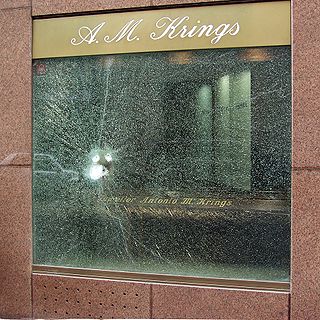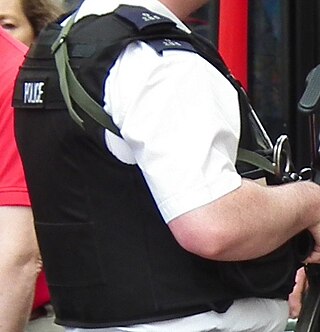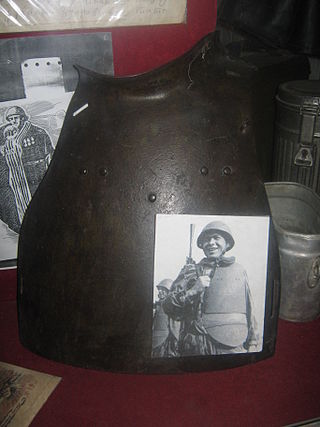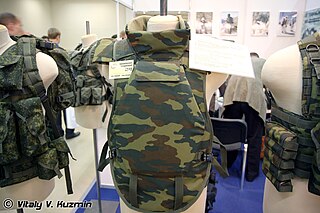Related Research Articles

A bulletproof vest, also known as a ballistic vest or a bullet-resistant vest, is an item of body armour that helps absorb the impact and reduce or stop penetration to the torso by firearm-fired projectiles and fragmentation from explosions. The vest may come in a soft form, as worn by many police officers, prison officers, security guards, and some private citizens, used to protect against stabbing attacks or light projectiles, or hard form, using metallic or para-aramid components. Soldiers and police tactical units wear hard armour, either in conjunction with soft armour or alone, to protect against rifle ammunition or fragmentation.
The Interceptor Multi-Threat Body Armor System (IBA) is a bullet-resistant body armor system that was used by the United States Armed Forces during the 2000s, with some limited usage into the mid-2010s. IBA and its design replaced the older standardized fragmentation protective Personnel Armor System for Ground Troops (PASGT) body armor system that was designed in the late 1970s and introduced in the early 1980s.

Bulletproof glass, ballistic glass, transparent armor, or bullet-resistant glass is a strong and optically transparent material that is particularly resistant to penetration by projectiles. Like any other material, it is not completely impenetrable. It is usually made from a combination of two or more types of glass, one hard and one soft. The softer layer makes the glass more elastic, so that it can flex instead of shatter. The index of refraction for all of the glasses used in the bulletproof layers must be almost the same to keep the glass transparent and allow a clear, undistorted view through the glass. Bulletproof glass varies in thickness from 3⁄4 to 3+1⁄2 inches.

Personnel Armor System for Ground Troops is a combat helmet and ballistic vest that was used by the United States military from the early 1980s until the mid-2000s, when the helmet and vest were succeeded by the Lightweight Helmet (LWH), Modular Integrated Communications Helmet (MICH), and Interceptor Body Armor (IBA) respectively.

A flak jacket or flak vest is a form of body armor. A flak jacket is designed to provide protection from case fragments ("frag") from high explosive weaponry, such as anti-aircraft artillery, grenade fragments, some types of pellets used in shotguns, and other lower-velocity projectiles. It is not designed to protect against bullets fired from most small arms such as rifles or handguns. However flak jackets are able to sustain certain gunshots, depending on the angle at which the shot was fired, the caliber of the bullet, the speed of the projectile and the range from which the shot was fired.

Body armor, personal armor, armored suit (armoured) or coat of armor, among others, is protective clothing designed to absorb or deflect physical attacks. Historically used to protect military personnel, today it is also used by various types of police, private security guards, or bodyguards, and occasionally ordinary citizens. Today there are two main types: regular non-plated body armor for moderate to substantial protection, and hard-plate reinforced body armor for maximum protection, such as used by combatants.

The Model 35 antitank rifle was a Polish 7.9 mm anti-tank rifle used by the Polish Army during the 1939 invasion of Poland. It was designated model 35 for its design year, 1935: It was also known by its codename "Uruguay", after the country and by the name of its designer, Józef Maroszek(pl).

Bulletproofing is the process of making an object capable of stopping a bullet or similar high velocity projectiles. The term bullet resistance is often preferred because few, if any, practical materials provide complete protection against all types of bullets, or multiple hits in the same location, or simply sufficient kinetic (movement) energy to overcome it.

The Small Arms Protective Insert (SAPI) is a ceramic ballistic plate used by the United States Armed Forces. It was first used in the Ranger Body Armor and Interceptor Body Armor, both are ballistic vests. It is now also used in the Improved Outer Tactical Vest as well as the Modular Tactical Vest, in addition to commercially available "plate carriers". The Kevlar Interceptor vest itself is designed to stop projectiles up to and including 9×19mm Parabellum submachine gun rounds, in addition to fragmentation. To protect against higher-velocity rifle rounds, SAPI plates are needed.

The M2 medium tank, officially Medium Tank, M2, was a United States Army medium tank that was first produced in 1939 by the Rock Island Arsenal, just prior to the commencement of the Second World War in Europe. Production was 18 M2 tanks, and 94 slightly improved M2A1 tanks, for a total of 112. Events in Western Europe rapidly demonstrated that the M2 was obsolete, and it was never used overseas in combat; it was, however, used for training purposes throughout the war.

A stab vest or stab proof vest is a reinforced piece of body armor, worn under or over other items of clothing, which is designed to resist knife attacks to the chest, back and sides. Stab vests are different from bulletproof vests, most of which offer protection against firearms but afford little against stabbing with sharp-tipped objects such as knives; most stab vests afford less protection against bullets, particularly those of high caliber, but are designed to prevent serious injury by prohibiting knife penetration beyond a few millimeters. Stab vests are also needle and slash proof.

Ranger Body Armor (RBA) is a US military-issue ballistic vest that was designed for, and used chiefly by, US Army 75th Ranger Regiment operators ("Rangers") in the 1990s and 2000s. The RBA system has since been replaced by other specialized body armor systems adopted by the United States Special Operations Command (USSOCOM).

The Improved Outer Tactical Vest (IOTV) is an enhanced version of, and a replacement for, the older Outer Tactical Vest (OTV) component of the Interceptor Multi-Threat Body Armor System, as fielded by the United States Army beginning in the mid-2000s. The IOTV is compatible with the Deltoid and Axillary Protector System (DAPS) components, ESAPI, Enhanced Side Ballistic Inserts (ESBI), as well as the OTV's groin protector. It has a flame-resistant standalone shirt, the Army Combat Shirt (ACS), designed specifically for use with the IOTV.
Ceramic armor is armor used by armored vehicles and in personal armor to resist projectile penetration through its high hardness and compressive strength. In its most basic form, it consists of two primary components: A ceramic layer on the outer surface, called the "strike face," backed up by a ductile fiber reinforced plastic composite or metal layer. The role of the ceramic is to (1) fracture the projectile or deform the projectile nose upon impact, (2) erode and slow down the projectile remnant as it penetrates the shattered ceramic layer, and (3) distribute the impact load over a larger area, which can be absorbed by ductile polymer or metallic backings. Ceramics are often used where light weight is important, as they weigh less than metal alloys for a given degree of resistance. The most common materials are alumina, boron carbide, and, to a lesser extent, silicon carbide.

Dragon Skin is a type of ballistic vest first-produced by the now-defunct company Pinnacle Armor, and was subsequently manufactured by North American Development Group LLC. The vest manufacturer claimed that it could absorb a high number of bullets because of its unique design involving circular discs that overlapped, similar to scale armor.
Lester D. Shubin was a researcher who developed Kevlar for the use in ballistic vests. Kevlar's use in ballistic vests was later expanded for use in all types of personal armor.

Steel breastplate, or Stalnoi Nagrudnik is a type of body armor similar to a cuirass developed by the Red Army in World War II. The native Cyrillic abbreviation for the vest was "СН", the Cyrillic letters Es and En. It consisted of two pressed steel plates that protected the front torso and groin. The plates were 2 mm (0.079 in) and weighed 3.5 kg (7.7 lb). This armor was supplied to SHISBr.

6B2 is a Soviet ballistic vest. It is the first serial mass issued body armor of the Soviet Armed Forces, designed on the eve of Soviet-Afghan war. It was introduced into service in 1981. Use of this vest decreased losses of Soviet troops and it became the basis for the further development of domestic personal protective equipment.

"Zabralo" is a series of ballistic vests created for the Russian Armed Forces under the supervision of GRAU for inclusion in the basic set of personal equipment "Barmitsa". They were intended as a replacement for the Soviet ballistic vests 6B3, 6B4 and 6B5. The Zabralo armors became a major stepping point for Russian armor development due to its design.
References
- ↑ Bull, Stephen. Encyclopedia of Military Technology and Innovation. (Greenwood Press: London) (2004) p. 19.
- ↑ Long, Allen. "New Clothing for Fighters". Science News Letter (February 21, 1953) p. 122.
- ↑ King, Ludlow (March–April 1953). "Lightweight Body Armor". The Quartermaster Review. Archived from the original on 15 July 2016.
- 1 2 Military Handbook: Survivability, Aircraft, Nonnuclear, Airframe Volume 2. The Department of Defense (1983)
- ↑ "Armored Vest Fact Sheet". Office of the Quartermaster General. 1952. Archived from the original on 6 March 2023.